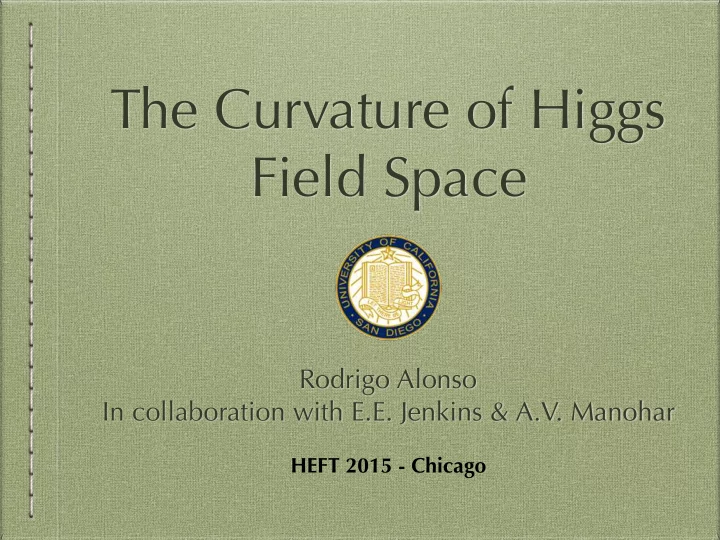

The Curvature of Higgs Field Space Rodrigo Alonso In collaboration with E.E. Jenkins & A.V. Manohar HEFT 2015 - Chicago
The Nature of the New Scalar Composite? Elemental? Mass Stabilization? Effective Field Theories helps us stay agnostic A tool to frame the BEH scalar This talk: a different view of (H)EFTs
Part I: Curvature
Started from the bottom W,Z Massive Gauge Bosons living in: SU(2) xU(1) /U(1) L Y Q One needs fields that live in the broken group to be sacrificed in the gauge bosons 3 altar: a three sphere S parametrized as:
Started from the bottom W,Z Massive Gauge Bosons living in: SU(2) xU(1) /U(1) L Y Q One needs fields that live in the broken group to be sacrificed in the gauge bosons 3 altar: a three sphere S parametrized as:
Started from the bottom Three Massive Gauge Bosons living in: SU(2) xU(1) /U(1) L Y Q 3 a three sphere S Defines the Gauge Covariant Derivative
Started from the bottom Three Massive Gauge Bosons living in: SU(2) xU(1) /U(1) L Y Q 3 a three sphere S The most general transformation is given by the Killing Vectors
Started from the bottom Three Massive Gauge Bosons living in: SU(2) xU(1) /U(1) L Y Q 3 a three sphere S So that we have a Gauge Covariant Derivative: and a Kinetic term:
Now the Higgs is here It is a singlet of the EW symmetry and appears where the NGB are, is it maybe the ‘radius’? 3 4 Then the sphere S gets expanded to R we have the SM Higgs doublet The Field Space turns FLAT but u still transforms non-linearly!
What Higgs is it? Let’s give him a kinetic term For Example:
Riemann Curvature How is the space the 4 scalars live on? 1 2 # of GB, 3 Functions of the singlet h characterizing Curvature
The Curvature and Physical Observables E.g. in an HEFT longitudinal boson scattering is not fully unitarized: [Barbieri, Bellazzini, Rychkov & Varagnolo; ’07] Which means new resonances are required at (NDA):
Connection with Composite Models 4 take O(5)/O(4) and therefore a 4-sphere, S [Agashe, Contino Pomarol; ‘05] where the function of the singlet in the metric: and curvature:
Part II: Curvature is useful
Functional Methods Partition Function and Effective Action: expanding the action around the classical solution 1-loop result:
Functional Methods 1-loop result: [t’Hooft; ‘73]
Functional Methods: HEFT Second variation of the action of HEFT Non-Invariant term!
Covariant Formalism The problem is we do not know [Honerkamp; ’72] [Tataru; ‘75] how to take derivatives So the second variation of the action is: Or equivalently we must use geodesics to deviate from the background field
HEFT at one-loop Introduce:
HEFT at one-loop times [Guo, Ruiz-Femenia & Sanz-Cillero; ’15] [RA,Jenkins, Manohar]
Non-invariant terms They are calculable with functional methods: and we can compare with the literature: [Gavela, Machado, Kanshin, Saa; ‘14] [Appelquist & Bernard; ‘81]
The Limits of HEFT SM Higgs; Flat Technicolor; Curved (=1/v) Composite Higgs; Curved (tunable) Dilaton; Flat to first order
Measure the Curvature Two curvature magnitudes: 1 quite constrained e.g. The second is hard to 2 measure
Is the Earth Higgs field round? . v f
Is the Earth Higgs field round? . v f –Thank You
Recommend
More recommend